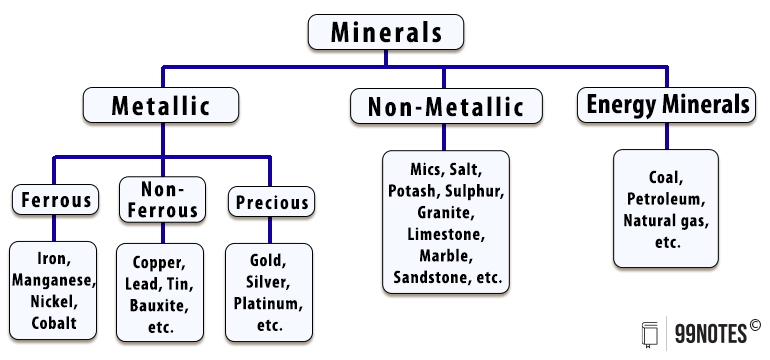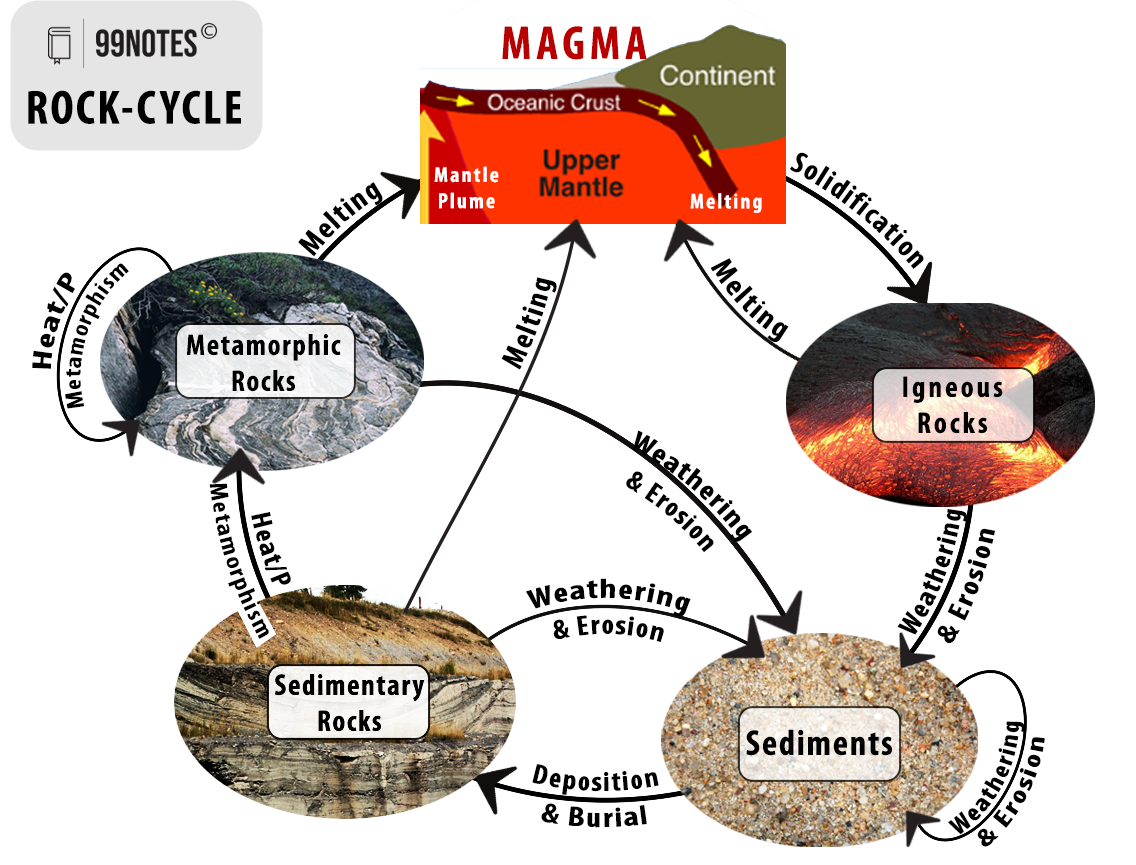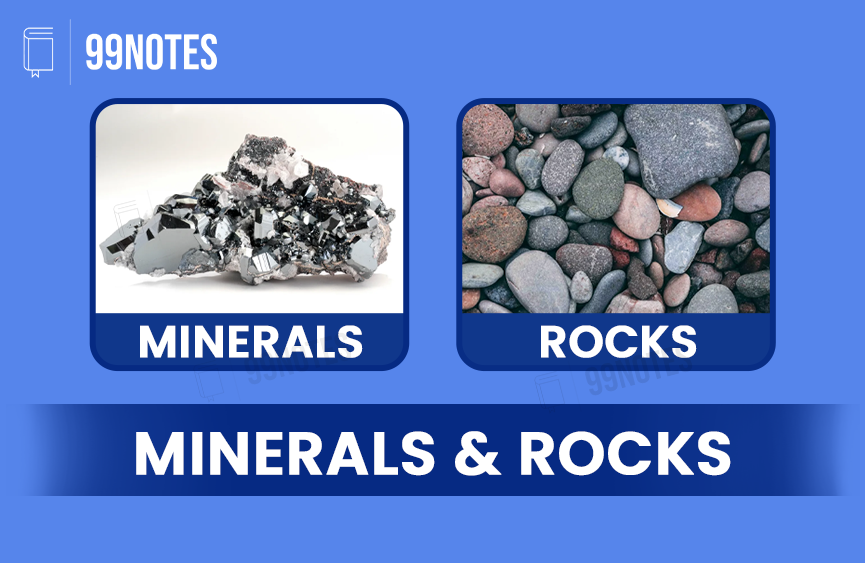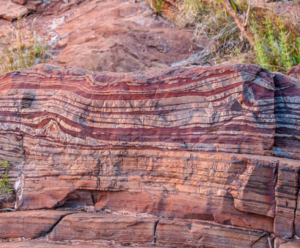Minerals and Rocks- UPSC Notes
About 98% of the total crust of the earth is composed of eight elements oxygen, silicon, aluminium, iron, calcium, sodium, potassium and magnesium. The details of the table are given:
| S. No. | Elements | percentage |
| 1. | Oxygen | 46.60 |
| 2. | Silicon | 27.72 |
| 3. | Aluminium | 8.13 |
| 4. | Iron | 5.00 |
| 5. | Calcium | 3.63 |
| 6. | Sodium | 2.83 |
| 7. | Potassium | 2.59 |
| 8. | Magnesium | 2.09 |
| 9. | Others | 1.41 |
Figure 3 Distribution of Elements on Earth’s crust
About 98% of the total crust of the earth is composed of eight elements oxygen, silicon, aluminium, iron, calcium, sodium, potassium and magnesium. The details of the table are given:
There are at least 2000 minerals, named and identified in the earth’s crust. Almost all the commonly occurring minerals are related to six Major rock-forming minerals. We have studied that the earth’s crust is made up of different minerals embedded in the rocks. Various metals are extracted from these minerals after proper refinement. Minerals are an indispensable part of our lives.
Almost everything we use, from a tiny pin to a towering building or a big ship, is made from minerals. Even the food that we eat contains minerals. In all stages of development, human beings have used minerals for their livelihood, decoration, festivities, and religious and ceremonial rites.
What is a mineral?
- What is a mineral?
- MODE OF OCCURRENCE OF MINERALS
- Where are these minerals found?
- Forms of Mineral Occurrence:
- Classification of Minerals:
- What are Rocks?
- Property of Rocks:
- Types of Rocks:
- Important Processes of Metamorphism:
- Some Major Minerals and their Characteristics:
- What is a Rock Cycle?
- FAQs related to Mineral and Rocks
Geologists define a mineral as a “homogenous, naturally occurring substance with a definable internal structure.” Minerals are found in varied forms in nature, ranging from the hardest diamond to the softest talc.
Physical Characteristics of Minerals:
-
- External crystal form — It is determined by the internal arrangement of the molecules — cubes, octahedrons, hexagonal prisms, etc.
- Cleavage — Minerals tend to break in given directions producing relatively plane surfaces result of the internal arrangement of the molecules — may cleave in one or more directions and at any angle to each other.
- Fracture — Internal molecular arrangements are so complex there are no planes of molecules; the crystal will break in an irregular manner, not along planes of cleavage.
- Lustre — Appearance of a material without regard to colour; each mineral has a distinctive lustre like metallic, silky, glossy etc.
- Colour — Some minerals have characteristic colour determined by their molecular structure like malachite, azurite, chalcopyrite etc., and some minerals are coloured by impurities. For example, because of impurities quartz may be white, green, red, yellow etc.
- Streak — Colour of the ground powder of any mineral. It may be of the same colour as the mineral or may differ, malachite is green and gives a green streak, and fluorite is purple or green but gives a white streak.
- Transparency —
- Transparent – light rays pass through so that objects can be seen plainly;
- Translucent — light rays pass through but will get diffused so that objects cannot be seen;
- Opaque — light will not pass at all.
- Structure — Particular arrangement of the individual crystals; fine, medium or coarse-grained; fibrous — separable, divergent, radiating.
- Hardness — Relative resistance being scratched; ten minerals are selected to measure the degree of hardness from 1-10. They are:
1. Talc 2. Gypsum 3. Calcite 4. Fluorite 5. Apatite 6. Feldspar 7. Quartz 8. Topaz 9. Corundum 10. Diamond. -
- Specific gravity — The ratio between the weight of a given object and the weight of an equal volume of water; the object weighed in air and then weighed in water and divided weight in air by the difference of the two weights.
MODE OF OCCURRENCE OF MINERALS
Where are these minerals found?
Minerals are usually found in “ores”. The term ore is used to describe an accumulation of any mineral mixed with other elements. The mineral content of the ore must be in sufficient concentration to make its extraction commercially viable. The type of formation or structure in which they are found determines the relative ease with which mineral ores may be mined. This also determines the cost of extraction. It is, therefore, important for us to understand the main types of formations in which minerals occur.
Forms of Mineral Occurrence:
Minerals generally occur in these forms.
-
-
- Igneous and metamorphic rocks minerals: They occur in the cracks, crevices, faults or joints. The smaller occurrences are called veins and the larger are called lodes. In most cases, they are formed when minerals in liquid/molten and gaseous forms are forced upward through cavities towards the earth’s surface. They cool and solidify as they rise. Major metallic minerals like tin, copper, zinc lead etc. are obtained from veins and lodes. (ii)
- Sedimentary rocks Minerals: A number of minerals occur in beds or layers. They have been formed as a result of deposition, accumulation and concentration in horizontal strata. Coal and some forms of iron ore have been concentrated as a result of long periods under great heat and pressure. Another group of sedimentary minerals include gypsum, potash salt and sodium salt. These are formed as a result of evaporation, especially in arid regions.
- Decomposition of surface rocks minerals: Another mode of formation involves the decomposition of surface rocks, and the removal of soluble constituents, leaving a residual mass of weathered material containing ores. Bauxite is formed this way.
- Alluvial deposit minerals: Certain minerals may occur as alluvial deposits in the sands of valley floors and the base of hills. These deposits are called ‘placer deposits’ and generally contain minerals, which are not corroded by water. Gold, silver, tin and platinum are the most important among such minerals.
- Soluble minerals: The ocean waters contain vast quantities of minerals, but most of these are too widely diffused to be of economic significance. However, common salt, magnesium and bromine are largely derived from ocean waters. The ocean beds, too, are rich in manganese nodules
-
Classification of Minerals:
A particular mineral that will be formed from a certain combination of elements depends upon the physical and chemical conditions under which the material forms. This, in turn, results in a wide range of colours, hardness, crystal forms, lustre and density that a particular mineral possesses. Geologists use these properties to classify the minerals.

What are Rocks?
Rocks are naturally occurring hard materials composed of minerals. It can be as hard as granite and as soft as Soapstone.
Property of Rocks:
-
-
- They come in a variety of colours, shapes and sizes. They can be Black as Gabbro and milky white as Quartzite.
- They can consist of one or more minerals. Some rocks, for instance, limestone, consist of a single mineral only, but the majority of the rock consists of several minerals in varying proportions. Although over 2000 minerals have been identified, only a few are abundantly found in most of the rocks.
-
| Petrology is a science of rocks. It studies rocks in all their aspects viz., mineral composition, texture, structure, origin, occurrence, alteration and relationship with other rocks. |
Types of Rocks:
Rocks can be classified into three types based on its origin:
- Igneous rock: (Ignis = Fire) It is formed out of Magma and Lava, which cools and solidifies after outpouring from the interior of the earth. It is also called as Primary rocks.
- Cooling can happen in the earth’s crust (intrusive) or on the surface (extrusive).
- Classified based on textures: Texture depends on the size and arrangement of grains or other physical conditions of the materials.
- If cooled slowly at great depths, mineral grains may be large.
- Sudden cooling: small, smooth grains.
- Intermediate cooling: intermediate sizes of grains.
- Examples: Granite, Gabbro, Pegmatite, Basalt, Volcanic Breccia and tuff.
- Sedimentary: (Sedimentum = settling) Rocks continuously are exposed and denudation agents keep them breaking into various sizes of fragments (soils): These are transported by exogenous agencies and deposited in a process called sedimentation. These sediments, when compacted under certain conditions, they turn into rocks.
Depending upon the mode of formation, Sedimentary rocks can be classified into three major groups:
- Mechanically formed (pressure): When these sediments. Sandstone, conglomerate, limestone, shale, loess
- Organically formed: geyserite, chalk, limestone, coal
- Chemically formed: Chert, limestone, halite, potash
- Metamorphic: (Metamorphic means: Change of form); Metamorphic rocks form when rocks are subjected to high heat, high pressure, hot mineral-rich fluids or, more commonly, some combination of these factors. When rocks are forced down to lower levels by a tectonic process or when molten Magma rises through the crust and comes in contact with crustal rock or underlying rocks, already consolidated rocks undergo recrystallization and reorganisation of materials within original rocks.
- Dynamic Metamorphism: Mechanical disruption reorganisation due to breaking and crushing without any appreciable chemical change.
- Thermal Metamorphism: Chemically alter and recrystallize due to Thermal metamorphism. This is of two types:
- Contact Metamorphism: Rock comes in contact with hot intruding magma and lava, and rock material recrystallizes under high temperatures. Quite often new material is added.
- Regional Metamorphism: Rock undergoes recrystallisation due to deformation caused by tectonic shearing together with high Temperature or Pressure or both.
Important Processes of Metamorphism:
Foliation or Lineation: In the process grains of minerals gest arranged in layers or lines. Such arrangement is called as Foliation or lineation.
-
-
- Metamorphic rocks are classified into two categories: Foliated rocks and Non-foliated rocks Ex: Gneissoid, Syenite, Slate, Schist, Marble, Quarzite etc.
-
Banding: Sometimes minerals or materials of different groups are arranged into alternating thin to thick layers appearing in light and dark shades called as Banding; Such Rocks having alternate layers are called as Banded rocks.
| Example of Banding – Banded Iron formation: |
|
Around 2.5 billion years ago, the earth became oxygen-rich for the first time due to the evolution of photosynthesis. This enabled the iron dissolved in the oceans to react with oxygen and form sediments of Ferrous oxides. These layered formations are now found on the earth as banded iron formations. Around 60% of all iron ores in the world are found in Banded Iron formations. For example, Mulaingiri formations in Karnataka (in western Ghats).
|
Some Major Minerals and their Characteristics:
| Editor’s Note |
| In general, the student must know about important minerals; However, UPSC rarely asks questions from this portion. |
-
-
- Feldspar: Feldspar is a group of rock-forming aluminium tectosilicate minerals, that also contain other cations such as sodium, calcium, potassium, or barium. Half of the earth’s crust is composed of Feldspar. It is a light Cream to Salmon pink colour. It is used in Ceramics and glass making.
- Quartz: It is one of the most important components of Sand and Granite. It constitutes 12% of the earth’s crust. It consists of Silicon. It is hard and virtually insoluble in water. It is a metamorphic form of sandstone. It is white or colourless and used in Radio and radar.
- Pyroxene: It consists of Ca, Al, Mg, Fe and Si. It is 10% of earth’s crust. Its colour is Green or black. It is commonly found in Meteorites.
- Amphibole: Its major element is Al, Ca, Si, Fe and Mg. It makes up 7% of earth’s crust. Hornblende is another form of the Amphibole. It is mostly Green or black in colour and used in the asbestos (Shades) industry.
- Mica: Its major elements are K, Al, Mg, Fe, Si etc. It constitutes 4% of the earth’s crust. Commonly as Igneous and Metamorphic rocks. It is primarily used in the electrical instruments.
- Olivine: Mg, Fe and Si are major elements. It is found in Basaltic rock. It is greenish crystal and used in Jewellery
- Other minerals: Chlorite, Calcite, Magnetite, Haematite, Bauxite and Barite are present in large quantities.
-
What is a Rock Cycle?
Rocks continuously undergo the process of creation and destruction, known as metamorphosis (‘morph’ means form), also known as the Rock cycle. This process is seen as a web of several processes that we have learnt above, involving all three types of rocks.
The Rock Cycle
-
-
- The molten magma cools and solidifies to become igneous rock. They are also called primary rocks, as these directly form out of the Magma.
- These igneous and Metamorphic rocks are broken down into small particles (soils) that are transported and deposited. They eventually fuse to form sedimentary rocks.
- When the igneous and sedimentary rocks are subjected to heat and pressure they change into metamorphic rocks.
- All these rocks can still get buried deep inside the earth to form a part of molten magma. This generally happens when a crustal plate subducts and is pushed into the mantle of the earth, as we have seen in the previous chapter.
- This molten magma again can cool down and solidify into igneous rocks.
-







